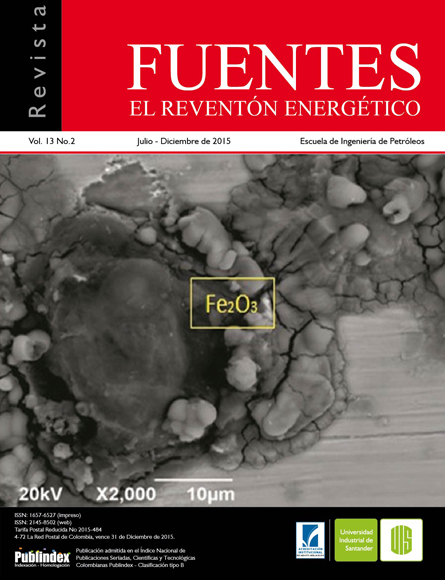Propuesta metodológica para el control y monitoreo de un proceso de inyección de agua
Published 2015-12-03
Keywords
- Water injection process,
- Intelligent completion,
- Hall Method,
- Injection zones
How to Cite
Abstract
Oil recovery through water injection process is the method that has contributed to the recovery of world oil, however, the changing characteristics in reservoir causing an ineffi cient oil sweep and a high operating cost.
The paper presents a refl ection of methods of control and monitoring implemented in water injection processes which allow effi cient scanning and increase the percentage of oil recovered. Based on this research it develops a methodology that describes a control system using selective strings with flow control valves driven from surface (intelligent completions) and a monitoring system using a diagnostic method called Hall Revised Method which together seeks maximum economic recovery of the deposit.
Downloads
References
2. Aljuri, C. C. (2005). Creación y desarrollo de la base de datos para el monitoreo de la inyección de agua en el campo Caño Limón - Arauca. Tesis pregrado, Facultad de Ingenierias Fisico-Quimicas. Universidad Industrial de Santander, Bucaramanga, Santander, 168pp.
3. Arashi, A., & Konopczynski, M. (2003). A Dynamic Optimisation Technique for Simulation of MultiZone Intelligent Well Systems in a Reservoir Development. Offshore Europe. Aberdeen, United Kingdom: SPE 83963.
4. Asadollahi, M. (2012). Waterflooding Optimization for Improved Reservoir Management. Tesis PhD. Faculty of Engineering Science and Technology. University of Science and Technology (NTNU), Trondheim, Norway, 145pp.
5. Atayero, A., Alatishe, A., & Ivanov, Y. (2012). Power Line Communication Technologies: Modeling and Simulation of PRIME Physical Layer. Proceedings of the World Congress on Engineering and Computer Science. San Francisco, USA: WCECS.
6. Bailey, B., Crabtree, M., Tyrie, J., Elphick, J., Kuchuk, F., Romano, C., & Roodhart, L. (2000). Control del agua. Oilfield Review, 12(1), 32 - 53.
7. Beveridge, K., Eck, J., Goh, G., Izetti, R., Jadid, M., & Scamparini, G. (2011). Terminaciones inteligentes modulares. Oilfield Review, 23(3), 18-27.
8. De, A., Silin, D., & Patzek, T. (2000). Waterflood Surveillance and Supervisory Control. SPE/ DOE Improved Oil Recovery Symposium. Tulsa, Oklahoma: SPE 59295.
9. Doublet, L. E., & Blasingame, T. (1996). Evaluation of Injection Well Performance Using Decline Type Curves. SPE Pennian Basin Oil and Gas Recovery Conference. Midland, Texas: SPE 35205.
10. Dyer, S., El-Khazindar, Y., Huber, M., Raw, I., & Reed, D. (2008). Terminaciones inteligentes: Manejo automatizado de pozos. Oilfield Review, 19(4), 4-17.
11. Ebadi, F., & Davies, D. (2006). Should “Proactive” or “Reactive” Control be Chosen for Intelligent Well Management? Intelligent Energy Conference and Exhibition. Amsterdam, The Netherlands: SPE 99929.
12. Fedenczuk, L., & Calgary, A. (2003). Monitoring, analyzing, and optimizing Waterflood Responses. SAS Conference Proceedings. Seattle, Washington: SUGI 28.
13. Hall, H. N. (1963). How to analyze waterflood injection well performance. World Oil, Octubre, 128-130.
14. IHS. (2014). Surveillance Analysis Theory. Retrieved from Fekete: http://www.fekete.com/SAN/ WebHelp/FeketeHarmony/Harmony_WebHelp/ Content/HTML_Files/Reference_Material/ Analysis_Method_Theory/Surveillance_Theory. htm
15.Jarrell, P., & Stein, M. (1991). Maximizing Injection Rates in Wells Recently Converted to Injection Using Hearn and Hall Plots. SPE Production Operations Symposium. Oklahoma City, Oklahoma: SPE 21724.
16. Mihcakan, I. M., Altinay, E., & Kasap, I. (2005). The Hall Plot Analysis of a Water Injection Test Affected by Geothermal Reservoir Response. Proceedings World Geothermal Congress. Antalya, Turkey.
17. Montaron, B., & Vasper, A. (2007). Intelligent Completions. Middle East & Asia Reservoir Review, 8, 6-21.
18. Naevdal, G., Brouwer, R., & Jansen, J. D. (2006). Waterflooding using closed loop control. Computational Geosciences, 10(1), 37-60.
19. Sakowski, S., Anderson, A. B., & Furui, K. (2005). Impact of Intelligent Well Systems on Total Economics of Field Developments. SPE Hydrocarbon Economics and Evaluation Symposium. Dallas, Texas: SPE 94672.
20. Saputelli, L., Ramirez, K., Chegin, J., & Cullick, S. (2009). Waterflood Recovery Optimization Using Intelligent Wells and Decision Analysis. Latin American and Caribbean Petroleum Engineering Conference. Cartagena, Colombia: SPE 120509.
21. Schrader, K. (2007). Intelligent completion reaches the dawn of its second decade. Recuperado el 20 de 05 de 2015, de Offshore: http://www.offshore-mag. com/articles/print/volume-67/issue 12/drillingcompletion/intelligent-completion-reaches-thedawn-of-its-second-decade.html
22. Silin, D. B., Holtzman , M. J., Patzek , T. W., Brink, J., & Minner, M. (Octubre 2005). Waterflood Surveillance and Control: Incorporating Hall Plot and Slope Analysis. Proceedings of SPE Annual Technical Conference and Exhibition. Dallas, Texas: SPE 93879.
23. Silin, D. B., Holtzman, R., & Patzek, T. W. (Abril 2005). Monitoring Waterflood Operations: Hall Method Revisited. Proceedings of SPE Western Regional Meeting. Irvine, California: SPE 95685.
24. Terrado, M., Yudono, S., & Thakur, G. (2007). Waterflooding Surveillance and Monitoring: Putting Principles Into Practice. Society of Petroleum Engineers, 10(5), 552-562.
25. Thakur, G. (1991). Waterflood surveillance Techniques - A Reservoir Management Approach. J. of Petrol. Technol., 43(10), 1-10.
26. Yang, Q., & Davies, D. (2009). A Generalized Predictive Control for Management of an Intelligent Well’s Downhole, Interval Control Valves - Design and Practical Implementation. Offshore Europe. Aberdeen, UK: SPE 123682
